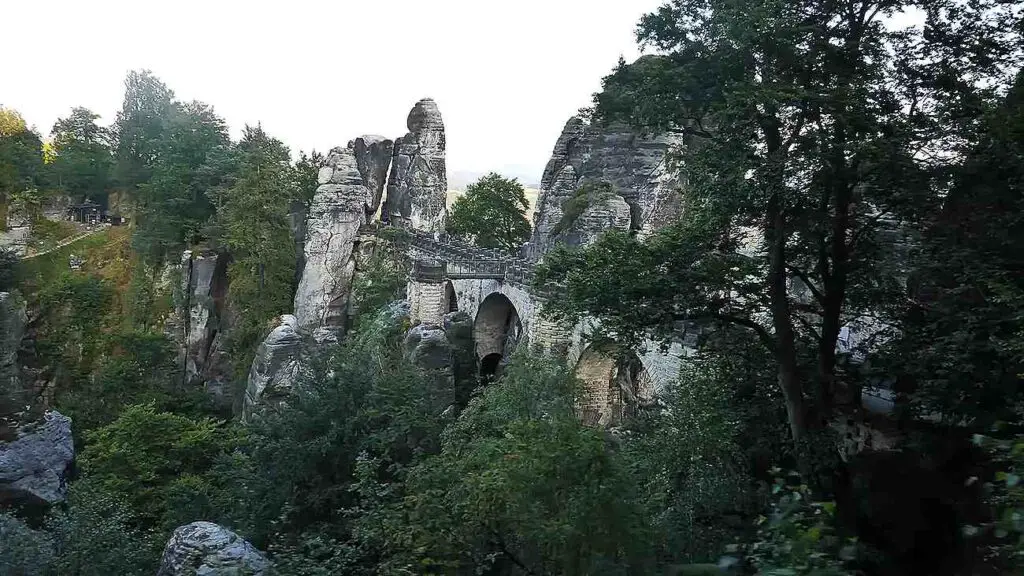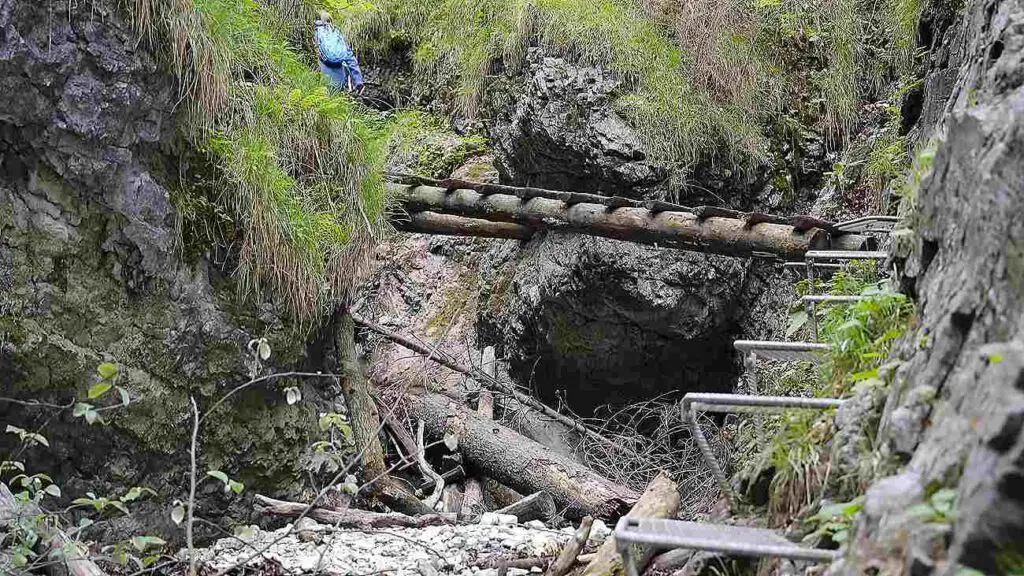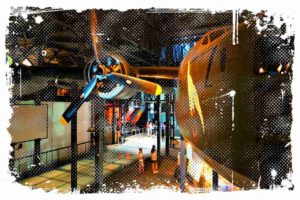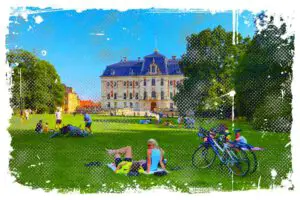You need to know that you don’t always need a plane to enjoy a beautiful vacation. If you’re in Poland, there are many amazing countries and locations just around the corner. I believe it’s a fantastic idea, especially if you’re planning a tropical backpacking trip later in the year.
I’ve got some suggestions, because I found places perfect for hiking enthusiasts and historical architecture lovers. And if you’re a wine lover, a railway fanatic, or a landscape photographer, I am sure you’ll find something that suits you. So, let’s hit the road and explore the beauty just beyond the border. Here are few spots to visit for a quick getaway.
1. The Island Of Rügen in Germany
If you’re looking for a gem, the German island of Rügen is it. I know that Rügen is one of the most beautiful and captivating islands in the Baltic, both geographically and from a tourism standpoint. Plus, it’s super easy to reach from Poland. It’s worth to say it’s a great spot for a quick weekend trip or a longer stay.

You’ll never find a dull moment here, with numerous attractions both natural and historical. There’s Jasmund National Park, home to stunning chalk cliffs, including a vertical rock formation known as the Royal Throne. This rock hovers above the surprisingly turquoise waters of the Baltic Sea.
↳ PRO TIP: Do you like traveling? Then before you buy any ticket or book an attraction, check if it's available in this worldwide Viator Database. You may save a lot of money and time. No need to thank me :)
The cliffs of Kap Arkona are equally breathtaking, marking the northeastern most part of Germany. This was the location of a significant Slavic stronghold before it was captured by Danish troops. Also, the entire experience can be topped off with a trip to the charming island of Hiddensee. This tiny island, adored by artists, is renowned for its Sea Buckthorn preserves.

Let me tell you, places like the elegant resorts of Sasnitz and Binz will leave a lasting impression. They’re extremely picturesque, especially Binz’s harbor. And if you’re traveling with children, they’ll love the historic steam railway known as the „Speeding Roland”.
Your entry point to the island is Stralsund, a gorgeous Hanseatic city boasting brick Gothic architecture and an interesting aquarium.

- This place is perfect for: Bicycle tourists, sea and beach lovers, historical monument enthusiasts, residents of west and north Polish.
- How to get there: Take the train from Świnoujście or Szczecin (line UBB or RE4) to Stralsund, then change to Sassnitz or Binz. If you’re driving, head from Szczecin on motorway No. 20 towards Rostock, then turn earlier to Stralsund by expressway.
- Where to sleep: Try Stralsund, Sassnitz, Binz. Check out the accommodation prices in these areas by clicking here.
2. Saxon Switzerland And The Elbe Gorge in Germany
If you want a dash of romance, I can tell Saxon Switzerland and the Elbe Gorge are where you should head to. Nestled in Germany’s Elbe Mountains, this place is a delight for nature enthusiasts, view seekers, and lovers of history and fascinating stories.

It’s worth to say the Elbe River’s picturesque canyon and sandstone rocks of various shapes and sizes are a sight to behold. Being there, you need to know that you’ll find rock cities, fortresses, isolated table mountains, and forests straight out of romantic poetry.

I am convinced the most famed and photographed attraction here is the Bastei. Its characteristic stone suspension bridge dangling over a deep chasm is absolutely stunning. You can easily spend an entire day exploring the expansive mountain fortress of Königstein. The views from its walls are some of Europe’s finest.

There’s never a dull moment while hiking along the trails of the Saxon Switzerland National Park. But if you’re a wine lover, head further down the river towards Pirna, Pillnitz. These areas are famous for their vineyards and delicious white wine.

- Ideal for: Mountain hiking enthusiasts, climbers, landscape photographers, wine connoisseurs, residents of the west and south Polish.
- How to get there: The best way is by train or Flixbus from Wroclaw to Dresden and then train to Bad Schandau. If you’re driving, go towards Gorlitz and Bautzen (worth a visit), then south or through the Czech Republic from Liberec and Decin. The Czech side also has some of these rock formations.
- Where to sleep: Dresden, Bad Schandau, Pirna. Check out the accommodation prices here.
3. Mysterious Zittau Mountains in Germany
If you’re after less-explored places, the Zittau Mountains could be your perfect getaway. Let me tell you, these are the smallest German mountains, and they’re just 20 minutes from the Polish border!

This region boasts of sandstone rocks and volcanic outliers in various forms, fragrant forests, morning mists hovering over meadows, villages with traditional wooden structures, and romantic ruins reclaimed by nature. Here, Germany, the Czech Republic, and Poland meet.

It is worth saying, you must visit Oybin, where the ruins of a castle loom over the town, and the equally mystical ruins of the Klosterkirche church. The area is peppered with rock outcrops and forests, and supposedly has Germany’s cleanest air, second only to the Baltic. You can reach Oybin by a unique, historic railway line from Zittau.

- Perfect for: Resort lovers, railway enthusiasts, mystery seekers, climbers, fans of the series „The Dark”, residents of the west and south Poland.
- How to get there: It’s a stone’s throw from Zgorzelec or Bogatynia. You can do it, no exaggeration!
- Where to sleep: Try the towns of Jonsdorf or Oybin. Check out the accommodation prices here.
4. Rock Towns in Czech Republic
Allow me to explain, the Czech rock towns are a geologist’s dream. Walking down from Sněžka to the town of Pec, we hopped on local railways to discover geological wonders right beyond the border.

I think it’s worth saying the Czech districts of Broumov and Trutnov, divided by an intricate network of rock towns, rank as one of Europe’s most interesting geologically. Plus, they’re so close to the Polish border, just a few kilometers away. They’re like a direct extension of what you’d see in our Stołowe Mountains. We’re quite lucky, indeed.

There’s plenty to choose from depending on your interests. Adrspaskie Rocks features towering, slender, bright outliers, and rock formations, as well as lakes with turquoise water and several trails.
Contrastingly, the Teplice Rocks are darker, forming narrow passages and corridors, where even Goethe found inspiration.
I recommend connecting both rock cities with one hike and returning by train. If you’re around longer than a weekend, make sure to explore the Broumov Walls, which are a direct extension of our Polish Stołowe Mountains and offer stunning viewpoints.

- Great for: Trail hiking and nature enthusiasts, mystery seekers, climbers, Czech food lovers, residents of the west and south Poland.
- How to get there: It’s straightforward – just cross the border at Kudowa-Słone or Mieroszów.
- Where to sleep: Try Adrspach, Teplice, or our personal recommendation, Penzion U Skalniho potoka in the middle of the National Park. Check out the accommodation prices here.
5. South Moravia in Czech Republic
If you’re after some Tuscan vibes without leaving far away, head to South Moravia in Czech Republic. It’s often dubbed „Bohemian Tuscany,” owing to its landscapes that bear a striking resemblance to Italy.

Especially in autumn, when the gently undulating vineyards signal the imminent harvest. The Pálava hills fit perfectly into this setting and offer excellent photo ops, thanks to the beautiful, soft light, abundant sunshine, trees, wine cellars dug into the ground, and expansive landscapes.

For hiking or cycling, consider the Podyjí National Park and its surroundings. If beautiful towns and history tickle your fancy, head to Znojmo, perched on the rocks of Mikulov, Moravian Krumlov, or even Brno.

If you’re a fan of romantic park and palace complexes, you’ll love the UNESCO-listed Lednice-Valdice complex, Europe’s largest and once the summer residence of the Liechtenstein family. You’ll need a decent chunk of time to cover this area, but it’s worth it.

- Ideal for: Cycling fans, history buffs, wine connoisseurs, residents of central and southern Poland.
- How to get there: Although it’s at the other end of the Czech Republic, close to the Austrian border, our A1 motorway will get you there in 3 hours, passing through Ostrava and Brno. Trains are an option, too. Just head towards Brno, then Breclav. Biking around for a few days and returning sounds like a good plan!
- Where to sleep: Try Znojmo, Mikulov, or near the reservoir Nove Mlyny. Check the accommodation prices here.
6. Moravian Karst in Czech Republic
Back to our southern neighbors, we’re off to Moravia again, a bit closer this time, near Blansko – the gateway to the renowned Moravian Karst. Covering over 90 square kilometers, it’s among the most valuable karst landscapes in Europe.
Unlike the towering rock cities and sprawling spaces of South Moravia, here, the treasure is underground.
I am convinced the karst’s highlight is its caves. Sure, there are msny, but only a few are open for visits. Among them are the Punkevni Cave, which features an unusual, famous karst funnel known as the Stepmother’s Abyss – a sight that can make you feel like you’re in Vietnam or Yucatan.
Other caves include the Balcarka caves, Vypustek cave, Katerinska cave, and a cave complex called Sloupsko-sosuvske caves. The latter is a crowd favorite as it offers a boat trip on the underground Punkva river.
- Ideal for: Hiking and cave enthusiasts, nature and geology lovers, Czech cuisine aficionados, residents of central and southern Poland.
- How to get there: Similar to the previous region, but you turn north near Brno. You can also take a train to Blansko, like almost anywhere else in the Czech Republic.
- Where to sleep: Try Brno, Blansko. Check the accommodation prices here.
7. Malé Karpaty and Trnava in Slovakia
In Western Slovakia lies a quaint mountain range known as the Little Carpathians. I know if you’re planning a trip to the Slovakian capital, Bratislava, you should also visit this picturesque region.

The Little Carpathians Landscape Park, with its headquarters in the town of Modra, offers hiking, beautiful landscapes, karst phenomena, and valuable historical monuments. You can explore the Driny Cave with its breathtaking stalactite forms and even picturesque vineyards on the gentle hills.
Many localities here are linked to wine, and in autumn, you can join fascinating festivals and grape harvest celebrations.
It is worth saying that the region also offers interesting attractions like castles, such as the Cachtice Castle, famous for its owner – Elizabeth Bathory, known as the „bloody countess.”
The Red Stone Castle, Beckov Castle, and Pajstun Castle are also worth visiting.
I am convinced that the city of Trnava could be an excellent starting point in this area. The city’s historic medieval Old Town, abundant sunshine, orange roofs, cafés, and blooming window sills give it a Mediterranean feel, making it the first city from the Polish border to offer such an ambiance.
- For whom?: Fans of light mountain hikes, Slovak cuisine, southern climates and coffee, wine connoisseurs, residents of central and southern Poland.
- How to get there?: You can reach Trnava via the D1 motorway from the Polish border, near Cadcy (Zwardoń on the Polish side). Alternatively, take a train from Český Těšín via Jablunkov or from the Tatra Mountains via Rozumberok.
- Where to sleep?: Try Pezinok, Trnava. Check the accommodation prices here.
8. Hungarian Danube Bend
Off we go, this time a bit further, to Hungary. Near Budapest, the picturesque Hungarian Danube Bend or Dunakanyar begins. An amazing find during our travels through Central Europe, it is an extraordinary section of the river valley. It offers not only breathtaking landscapes but also historic cities.

The first capital of Hungary, Esztergom, lies here, where you can find the country’s largest cathedral. Just across the Danube is the Slovak town of Sturovo, connected by a bridge. Then there’s Szentendre, where you can taste the Mediterranean climate and admire the colorful tenement houses in the historic market square.

We can relish in local langosze and sweet peppers, and we can „jump” to Budapest using a Danube ship or a suburban railway. Lastly, we have Visegrad, the second capital of Hungary, known for its royal palace and remains of a citadel overlooking the Danube. The view of the Danube from the castle is simply breathtaking.

- Who is it for? History buffs, fans of southern climates, cycling and railway enthusiasts, Hungarian cuisine and wine lovers, residents of southern, central, and eastern Poland.
- How to get there? The longest route yet, about 5 hours from the border, takes us through Slovakia and enters Hungary from Sturov’s side or via the highwsy from Bratislava. Alternatively, take a train to Bratislava and switch to Budapest Kaleti. You can get off in Vac or Nagymaros-Visegrád, opposite Vyšehrad.
- Where to sleep? Consider Esztergom, Vysegrad, Szentendre. Check the accommodation prices here.
9. Slovak Paradise
The Tatra Mountains symbolize not only Poland but also Slovakia. While skiers are familiar with the Low Tatras, hikers, climbers, and photographers appreciate the Slovak paradise. Here, you can immerse yourself in the breathtaking landscape shaped by the erosive activity of the Hornad River.

The trails cater to a variety of tourists, from the physically fit to the more „weekend” type, and even those on bicycles. Highlights include suspension bridges, chains, or ladders leading to the top of one of the hills. It is worth saying, these features add a thrilling element to the Slovak Paradise experience.

Listen to the river and forest sounds, gaze at the picturesque gorges, canyons, streams, waterfalls, and caves – like the famous Ice Cave in the southern part of the Slovak Paradise. These are the park’s main attractions.
And of course, there are the spectacular views of the Tatra Mountains’ peaks, especially from Tomasova Vyhlidka, a viewpoint near Spišská Nová Ves.

- Who is it for? Fans of mountain hiking, climbing, nature and cave enthusiasts, lovers of landscape photography, and residents of the southern, central, and eastern Poland.
- How to get there? From the border crossings in Lysá Polana and Piwniczna, head towards Poprad and Spišská Nová Ves. You could also take winding roads to the holiday villages Dedinky Mlynky on the massif’s other side. Trains from Poprad and Košice, as well as from the north, are also available.
- Where to sleep? Poprad and Spišská Nová Ves would be great bases. Check the accommodation prices here.
We hope you loved our suggestions. Do share your experiences if you’ve been to these places. Are you considering a direction? Let me know via email. We would be delighted if you share this guide with others. Now, do you have any picks to share? I’d love to hear your suggestions. Just remember, the destination should be a maximum of 3 hours from the Polish border.
References:
- https://zpe.gov.pl/pdf/P16Y4uNnY
- https://www.well.pl/life/148/najlepsze_atrakcje_turystyczne_w_europie_te_miejsca_warto_odwiedzic_w_2023_roku,11623.html
- https://www.national-geographic.pl/traveler/artykul/50-miejsc-w-europie



